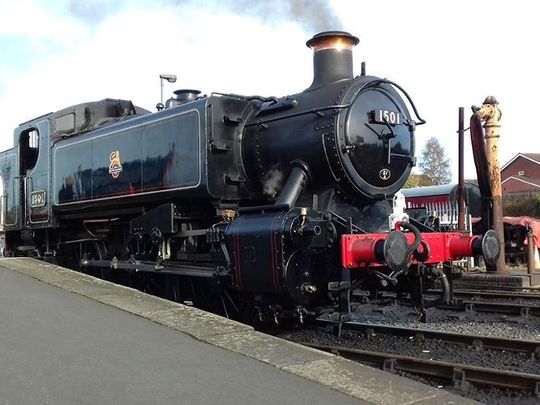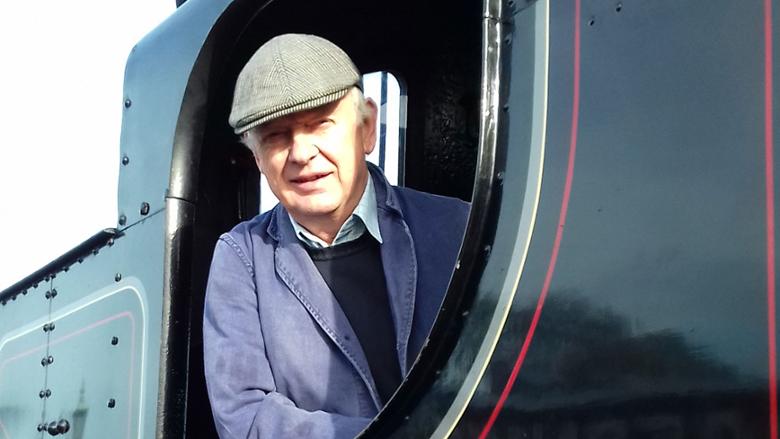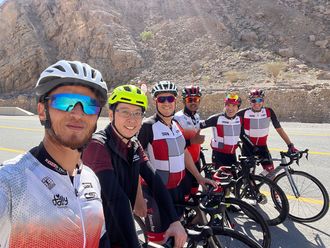
Pete Cherry, 71, has the dream job of a million youngsters, and gets to toot his whistle on a 16-mile stretch of track that cuts through some beautiful British countryside. Here, the steam lover tells us about icy cabs, Sherlock Holmes films and why steam has well and truly had its day.

Did you always want to be a train driver when you were a child?
Not really, although I had a love of steam railways. Steam finished on British Rail in August 1968, which coincided with me moving to Birmingham for my first job, and not long after arriving I went down to the Severn Valley Railway, which is a heritage railway that was set up to preserve a section of the line. I quickly got involved in their loco department and went through all the stages of training before becoming a driver in 1982. I’ve been driving ever since, purely as a volunteer.
What’s the Railway’s history?
It was very much a working railway, completed in 1862, but it was closed by British Rail in 1963. The first Severn Valley Railway Society was formed two years later. Our first locos arrived in 1967 and we started operating a proper public service in 1970, initially just on four-and-a-half miles of track, but it has extended over the years until, in 1984, we started on the 16 miles of track we have now.
Is competition for the role of train driver fierce amongst the volunteers?
I don’t know about fierce because different people have different aspirations, but if you join the loco department then it’s almost certain that your aspirations will be to become a driver. There’s quite a progression path. You start off as a cleaner and every few weeks you will have to go down and clean locos that are in use and then maybe a year or two later you might go on to start lighting the loco up and you learn about the boiler. Then you might go on to learn how to become a fireman. Finally, maybe some years after that you would pass the rules and regulations to become a driver, which is more or less the pinnacle of the promotional ladder.
What’s a typical day for you?
At about 5am on the day the train will be in use someone will come in to get the fire going. The fireman and the driver’s job is to check over the loco and oil up everywhere and that can take anything up to two hours. You take on water, you take on coal, and the first train will typically get off at 11am. We do two round-trips and then in the evening you go back to the shed to clean the fire, drop the ash and all the jobs that had do be done in the British Rail days. And these are the jobs that make you realise why they wanted to get rid of the things in the first place!
What’s your favourite part of the job?
It’s just driving, really. I don’t think anybody particularly enjoys raking ash out at the end of the day – it’s just one of those jobs that you have to do as part of the process. They were still building steam trains in India until 1971 and in China until about 1985, but even those countries have completely got rid of steam now. I don’t think there is anywhere in the world that they are used on a normal day-to-day schedule. China was the last country that really used steam to a large extent because they had a huge supply of cheap labour and coal and they didn’t bother too much about the environment back then.
Are passengers allowed in the cab, and if so do they always want to have a go on the whistle?
They always want to have a go on the whistle, yes. We’re quite happy for people to visit the cab when we’re in the station, and on a regular basis we do what we call “footplate experience courses” and I’m quite often the instructor on those. People come along and they get to drive the train and fire the train as well. One thing that you certainly get to notice is how few people actually know how to hold a shovel properly!
How hot is it in the cab?
It can be quite hot but on a really cold day you don’t feel the heat at all. There was one occasion a few years ago when it was minus-23 degrees and there were icicles hanging from the cab roof. The fact that you’ve got the fire going right next to you made no difference at all. But on a hot day it can be quite insufferable – it’s another reason why steam finished: the conditions are not what people would accept for a normal job these days. We are enthusiasts and we like to keep the old traditions alive, but you can understand why people who had to do this on a daily basis didn’t want to do it any more.
Everyone has a soft spot for steam thanks to the Hogwarts Express in Harry Potter – does filming ever happen on your railway?
Yes, filming can be quite lucrative and we’ve had a few here over the years, although no really famous ones. One was a Sherlock Holmes film many years ago and it was awful.
Other than regulating steam and handling the brakes, what else does a driver do?
One important thing is keeping a good lookout. You don’t have the good visibility that you do with modern trains, so a lot of the time you’re trying to see where you’re going and part of the fireman’s job is to keep a lookout, too.
Do children still want to be a train driver?
Oh, some do. The problem is that we have an ageing population of workers on the railways. People like me remember steam from when we were kids, but people aged under 50 don’t really remember it at all. Even so, we do have a surprising number of people who are interested and some of our drivers are in their 20s.
Are steam trains ripe for a comeback, or are they a dirty, messy – if fun – relic of a bygone era?
The latter. There’s no way that financially or environmentally you will ever get steam coming back. With modern technology they could certainly be made a lot more efficient than they once were, but when you see how horribly inefficient they are in terms of the amount of work you get out of them compared to the calorific value of the coal, it’s horrendous. Steam didn’t stand a chance of surviving any longer than it did, really.












